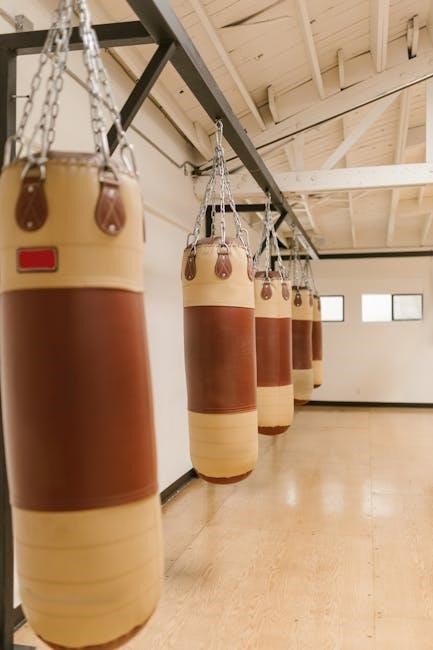A hole punch centering guide ensures precise alignment and accuracy when creating holes in various materials, making it essential for professional and DIY projects alike.
What is a Hole Punch Centering Guide?
A hole punch centering guide is a tool or device designed to help users accurately center and align holes in various materials, such as metal, plastic, or wood. It typically features measurements or markers that indicate the center point of the material, ensuring precise placement of the hole punch. This guide is especially useful for projects requiring symmetry or exact positioning, such as crafting, DIY projects, or industrial applications. By eliminating guesswork, it enhances efficiency and reduces the risk of misalignment. The guide often works in conjunction with hole punches, drills, or other tools, making it an essential accessory for achieving professional-grade results. Its simplicity and effectiveness make it a valuable tool for both beginners and experienced craftsmen.
Importance of Accurate Hole Punching
Accurate hole punching is crucial for ensuring structural integrity, functionality, and safety in various applications. Misaligned holes can lead to mechanical failures, compromised safety, and increased repair costs. In manufacturing and construction, precise alignment is essential for proper fitting of components, preventing costly rework and material waste. DIY enthusiasts benefit from professional-looking results, enhancing project quality. Accurate hole punching also minimizes the risk of weak points in materials, which could lead to potential hazards. By ensuring consistency and reducing errors, it saves time and resources, making it a vital step in achieving reliable and durable outcomes across industries.

Understanding the Basics of Hole Punching

Hole punching is a common task requiring precision to create accurate holes in materials like paper, metal, or plastic, using specialized tools for consistent results.
What is Hole Punching?
Hole punching is a process of creating precise, circular openings in materials like metal, plastic, or leather using specialized tools. It involves aligning and striking a punch tool to achieve clean, accurate holes. Commonly used in crafting, DIY projects, and industrial settings, hole punching requires careful measurement and alignment to ensure desired results. The process is essential for tasks such as installing hardware, making jewelry, or organizing materials. Different tools, like hand punches or power-driven machines, cater to various materials and hole sizes. Proper technique and the right tools ensure professional-looking finishes without damaging the material.
Tools and Materials Needed

To effectively use a hole punch centering guide, you’ll need specific tools and materials. A high-quality hole punch tool is essential, along with a sturdy work surface. A marking gauge or measuring tape ensures accurate measurements. Grid paper can help visualize hole placements. Clamps or a vise are necessary to secure the material firmly. Safety gear, such as gloves and safety glasses, protects you during the process. Additional tools like a drill press or hand punch may be required depending on the material type and thickness. Proper alignment tools, such as a centering guide, are crucial for precision. Gathering all these items beforehand ensures a smooth and efficient hole-punching experience.
Choosing the Right Hole Punch Centering Guide
Selecting the right guide involves considering material thickness, tool compatibility, and desired accuracy to ensure precise and efficient hole punching for your specific needs always.
Factors to Consider
When selecting a hole punch centering guide, consider the material thickness, type, and durability. Ensure the guide aligns with your punch tool for consistent results. Check for adjustable features to accommodate different hole sizes. The guide’s build quality and ease of use are crucial for long-term efficiency. Environmental factors like humidity or temperature may affect accuracy, so choose a guide suitable for your workspace conditions. Proper alignment mechanisms and secure clamping systems are essential to prevent misalignment. Additionally, assess the guide’s compatibility with various materials, such as metal, wood, or plastic, to meet your specific needs. Prioritize tools with precise measurements and durable construction for optimal performance.
Popular Types of Hole Punch Guides
Several types of hole punch centering guides are available, each offering unique benefits. Adjustable guides allow for flexibility across different material thicknesses, while laser-guided systems provide precise alignment. Magnetic guides are ideal for metal surfaces, ensuring stability. Spring-loaded guides offer easy positioning, reducing manual effort. Each type caters to specific needs, enhancing accuracy and efficiency in various applications.
Step-by-Step Guide to Using a Hole Punch Centering Guide
Measure and mark the material, align the punch with the mark, secure it firmly, and apply steady pressure to create a centered hole effortlessly.
Measuring and Marking the Material
Accurate measurement is the first step in achieving precise hole alignment. Use a ruler, caliper, or measuring tape to determine the exact center point of the material. Mark the center clearly with a pencil or marker to serve as a visual guide. For symmetrical projects, ensure the mark aligns with the material’s edge or established reference points. Double-check the measurements to avoid errors. If the material is thicker or uneven, consider using a straightedge or protractor to ensure straight lines and proper angles. Proper marking ensures the hole punch guide aligns correctly, leading to clean, centered holes. This step is critical for achieving professional-grade results in any project.
Aligning the Hole Punch
Accurate alignment is crucial for achieving a centered hole. Begin by placing the material on a stable surface and locating the center mark. Position the hole punch directly over the mark, ensuring the guide aligns with the edges of the material. Use a ruler or grid to double-check the alignment, especially for precise applications. For materials with visible grids or patterns, align the punch with the centerlines to maintain symmetry. Once aligned, gently press the punch down, applying steady pressure to avoid shifting. Proper alignment ensures clean, professional results and minimizes the risk of errors. Always verify the position before punching to achieve the desired outcome. This step is essential for both handheld and mechanical hole punches, ensuring consistency and accuracy in every application.
Securing the Material
Properly securing the material is crucial for accurate hole punching. Use clamps, a vice, or adhesive-backed foam to hold the material firmly in place. Ensure the surface is flat and stable to prevent movement during punching. For delicate materials, consider using non-slip mats to avoid scratching or slipping. Adjust clamps tightly but avoid over-tightening, which might deform the material. Double-check the alignment before securing to maintain precision. A stable setup ensures safety and consistent results, making the punching process efficient and stress-free.
Punching the Hole
Punching the hole is the final step after proper alignment and securing the material. Ensure the punch is firmly positioned and aligned with the marked center. Apply steady, even pressure to avoid slipping or misalignment. For manual punches, strike the handle with a mallet or squeeze firmly, depending on the tool type. For powered tools, follow the manufacturer’s instructions for operation. Always maintain control to prevent accidents. After punching, inspect the hole for accuracy and cleanliness. If necessary, deburr the edges for a smooth finish. Proper technique ensures precise results, making the process efficient and safe. Avoid rushing to maintain consistency and quality in your work.

Best Practices for Centering Holes
For precise hole centering, use a marking gauge to measure accurately. Clamp materials firmly to prevent shifting. Align the punch with the center mark carefully.

Ensuring Precision
Ensuring precision when using a hole punch centering guide requires careful preparation and attention to detail. Start by selecting the right punch tool and guide for your material thickness and type. Proper alignment is critical—use the guide to mark the center point accurately. Double-check measurements before punching to avoid errors. Secure the material firmly to prevent movement during the process. Using a stable work surface and maintaining the tool in good condition also enhances accuracy. Practice on scrap material if unsure about the setup. Consistency in technique and adherence to best practices will yield precise, centered holes every time, making your projects look professional and well-crafted.
Avoiding Common Mistakes
Avoiding Common Mistakes

When using a hole punch centering guide, common mistakes include misalignment, insufficient securing of the material, and neglecting to ensure the tool is in good condition. Misalignment can lead to off-center holes, which may compromise the integrity of the project. To avoid this, double-check the alignment before punching. Insufficient securing can cause the material to shift during the punching process, resulting in uneven holes. Always clamp or hold the material firmly in place. Additionally, using a dull or damaged punch can lead to inaccurate results. Regularly maintain and sharpen the tool to ensure clean, precise cuts. By addressing these issues, you can achieve consistent and professional-looking holes in your projects.
Maintaining the Tool
Regular maintenance of a hole punch centering guide is crucial for its longevity and performance. Start by cleaning the tool thoroughly after each use to remove any debris or residue. Lubricate moving parts to ensure smooth operation and prevent rust. Store the guide in a dry, secure location to avoid damage. Inspect the tool periodically for signs of wear or misalignment and address these issues promptly. Sharpen the punch occasionally to maintain sharpness and prevent dulling. Always follow the manufacturer’s maintenance instructions for optimal results. Proper care ensures consistent accuracy and extends the tool’s lifespan, making it a reliable asset for your projects.

Common Mistakes to Avoid
Common mistakes include misalignment of the punch and guide, insufficient securing of the material, and using dull tools, which can lead to inaccurate holes and damage.
Misalignment Issues
Misalignment is a common problem when punching holes, leading to uneven results and wasted material. It often occurs due to improper positioning or movement of the material during the punching process. A hole punch centering guide helps eliminate this issue by providing a clear reference point, ensuring the punch strikes the center of the marked area. Without proper alignment, holes may be offset, affecting the overall quality and functionality of the project. Regularly checking the guide’s accuracy and securing the material firmly can prevent such errors. Misalignment issues are especially critical in precise applications, such as metalwork or crafting, where symmetry and accuracy are essential.
Insufficient Securing
Insufficient securing of the material is a common mistake that can lead to misaligned holes or damaged equipment. When the material is not properly clamped or held in place, it may shift during the punching process, resulting in inaccurate holes. This issue is particularly problematic in thicker or harder materials, where movement can cause the punch to slip or break. To avoid this, always use clamps or a stable workstation to keep the material firmly in place. Additionally, ensure the hole punch is aligned correctly before applying force. Proper securing not only improves accuracy but also enhances safety by preventing unexpected movement or tool failure during operation. Addressing this issue is crucial for achieving professional-grade results in any project.
Factors Affecting Hole Punch Accuracy
Material thickness, type, and tool condition significantly impact accuracy, as do environmental factors like temperature and humidity, which can alter material properties and alignment precision.
Material Thickness and Type
Material thickness and type significantly impact the accuracy of hole punching. Thicker materials may require more force, potentially causing misalignment, while softer materials like plastics or woods may deform easily. The hole punch centering guide helps maintain consistency across various materials by providing a stable reference point. Different materials also have unique properties, such as flexibility or hardness, which can affect how cleanly a hole is punched. Using the correct guide ensures that the punch aligns properly, regardless of the material’s thickness or type. This consistency is crucial for achieving professional results in both industrial and DIY projects. Proper alignment prevents uneven holes and extends the lifespan of the punching tool. Always consider the material’s characteristics when selecting a guide for optimal performance.
Tool Condition

The condition of your hole punch tool significantly impacts accuracy. A dull or worn-out punch can lead to misaligned holes and uneven edges. Regular maintenance, such as sharpening the punch and replacing worn components, ensures optimal performance. Cleanliness is also crucial; debris or residue can affect alignment and precision. Proper storage in a dry, protected environment prevents rust or damage. Using a well-maintained tool not only improves results but also extends its lifespan. Neglecting tool condition can result in inconsistent hole quality, making precise centering difficult to achieve. Always inspect your tool before use and address any issues promptly to maintain reliability and consistency in your projects.
Environmental Factors
Environmental conditions significantly impact the accuracy of hole punching. Temperature fluctuations can cause materials to expand or contract, affecting alignment. Humidity may alter the dimensions of certain materials, such as paper or thin metals, leading to misalignment. A stable workshop environment is crucial for precise results. Vibrations from nearby machinery or uneven surfaces can disrupt the punching process. Additionally, lighting conditions play a role; poor visibility may lead to improper alignment. To mitigate these factors, use a climate-controlled workspace and ensure the surface is level and free from vibrations. Regularly calibrate tools to account for environmental changes. Maintaining consistent conditions enhances the reliability of your hole punch centering guide and ensures professional-grade outcomes.

Safety Tips When Using a Hole Punch
Always wear safety glasses and keep loose clothing tied back. Ensure the work area is clear and stable. Avoid distractions while punching holes.
Protective Gear
Using a hole punch centering guide requires proper safety measures to prevent injuries. Always wear safety glasses to protect your eyes from flying debris. Gloves are essential to maintain a firm grip and prevent hand injuries. A dust mask is recommended when working with materials that generate dust or particles. Ensure long hair and loose clothing are tied back to avoid accidental entanglement with the tool. Steel-toe shoes are advisable in industrial settings to safeguard feet from heavy objects. Proper protective gear ensures a safe and efficient hole-punching experience, minimizing risks and allowing you to focus on achieving precise results.
Work Area Safety
Ensuring a safe work area is crucial when using a hole punch centering guide. Always clear the workspace of clutter and ensure the material is stable to prevent accidents. Proper lighting is essential for visibility, reducing eye strain and mistakes. Keep loose clothing or long hair tied back to avoid entanglement with tools. Additionally, ensure the floor is free from tripping hazards and that all safety gear, like gloves, is within reach. Regularly inspect the tool and surrounding area for damage or wear. A clean and organized workspace not only enhances safety but also improves efficiency and accuracy when punching holes. Always prioritize a tidy environment to minimize risks and ensure smooth operations.


